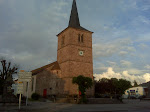Almost six months to the day before Camille died this past February, he and his wife Lucette and the three of us walked to one of our favorite spots in the Vosges, Belbriette, a hidden valley unknown even to some locals, and then had lunch in one of his favorite restaurants, l'Auberge de Belbriette.
 Two months before he passed, Camille was still swimming for exercise in the local pool. He would have been 89 years old this summer. He was a renowned photographer in France, a decorated World War II hero, a member of the French Resistance, the founder of the basketball program in Granges, father, friend, mentor, coach. His absence is felt profoundly by all who knew him and many who didn't.
Two months before he passed, Camille was still swimming for exercise in the local pool. He would have been 89 years old this summer. He was a renowned photographer in France, a decorated World War II hero, a member of the French Resistance, the founder of the basketball program in Granges, father, friend, mentor, coach. His absence is felt profoundly by all who knew him and many who didn't. When we visit his wife Lucette, it is as she has said--as though any minute he would come walking in the door carrying either his camera bag or his fishing equipment.
 Yesterday, the local chapter of the Veterans association in France honored Camille with a ceremony and a commemorative plaque on his tomb. The mayors of the surrounding towns came, and his war history was read, including his efforts to support the American troops by sabotaging the Germans who were occupying the area, and by hiding and transferring supplies and weapons dropped by plane.
Yesterday, the local chapter of the Veterans association in France honored Camille with a ceremony and a commemorative plaque on his tomb. The mayors of the surrounding towns came, and his war history was read, including his efforts to support the American troops by sabotaging the Germans who were occupying the area, and by hiding and transferring supplies and weapons dropped by plane.Lucette calls Camille a phenomenon, and that is what he was--a once-in-a-lifetime phonomenon who loved life and loved people, and who left a hole in the world that will not be filled.
 Camille was a believer--he loved to go sit at the foot of the statue of Mary that stands in the woods above Granges, and pray. On his deathbed he called for the priest and was given last rites. We will meet him again--we'll probably find him organizing a basketball tournament (Angels vs. New Arrivals?)!
Camille was a believer--he loved to go sit at the foot of the statue of Mary that stands in the woods above Granges, and pray. On his deathbed he called for the priest and was given last rites. We will meet him again--we'll probably find him organizing a basketball tournament (Angels vs. New Arrivals?)!One last thing--For Camille's 80th birthday, we brought him a basketball signed by Coach K of Duke that reads, "From Coach K to Coach C." From the hospital not long before he died, Camille told Lucette to be sure Ren gets that basketball. Even then he was thinking of others.
















































